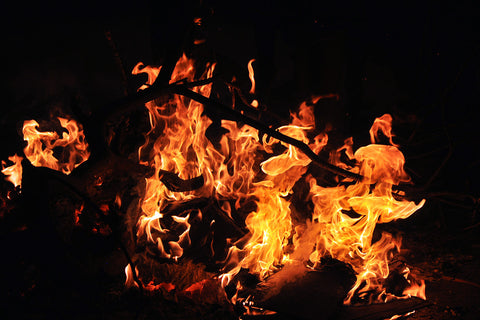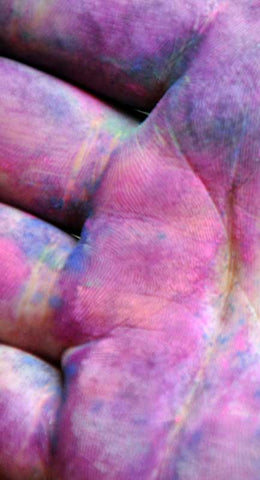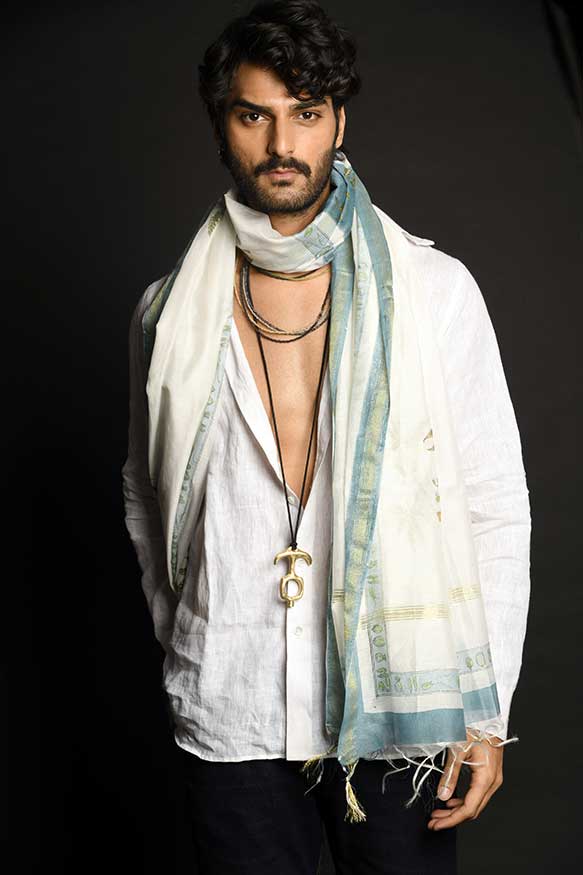Holi commemorates murder, jealousy and redemption in the play of Hindu gods.
Not long ago when most people lived in a brown world...color signified luxury, energy and status. Another place, another time, social allure alone might explain the Indian fervor for technicolor abandon—but Holi has dimensions that make it an inherently dramatic social release.
The holiday commemorates murder, jealousy and redemption in the play of Hindu gods. It is also a mash-up of religion, revenge, social mixing and block party stirred-in with the simple pleasures of looking. Hot pink, cobalt blue and saffron yellow hang in the air like descended auroras—for this is how to celebrate the gods. Holi is unlike anything else, anywhere else. Come to Mumbai's Koli fishing village for Holi's night of fires and day of colors.
Spring in India
Hindus celebrate Holi on full moons at the spring equinox. Holi is not a religious holiday that necessitates temple visits. Cosmologically and perhaps, spiritually, it is most similar to Christian Easter.
Set by the stars, both holidays celebrate the arrival of spring and the promised triumph of good over evil. Similarities end there. Visually, western Easter is pastel and sweet. Indian Holi pulses with dark imagery, Bollywood music and hot, vivid color. On a purely visual level, the holiday is so intense that it blasts into the brain's pleasure centers. Years later, I can close my eyes and go there still.




Winter mornings in India are enveloped in highly atmospheric light; a beautiful (if worrying) effect of dung fires still burned for heat and light. In that thrall, people don’t appear to you in the normal way. The gauzy light delays arrival; as if the thing you're seeing is behind a theater scrim. You don't see detail until the person, place or thing are so close they pop through in full Kodachrome.
Holi Preparations
About two weeks before Holi on an early morning very much like that, I was in a pony cart headed to see the holy city of Benares from a boat on the Ganges. On the way, I noticed wooden branches collecting in the middle of a traffic circle.
The pile grew over the days until the roundabout was hardly usable by cars. I asked an Indian friend about the woodpile and he explained Holi to me unenthusiastically. In mixed expletives, he told me that the fuel comes from winter-fallen branches collected by a community for Holi’s night of fires. He vowed to stay inside that day for fear of ruined clothes and “hooligans”. I ached to see it.
Holika and Prahlada
The BBC explains the Holi story of Holika and Prahlada this way: “Prahlada was the son of king Hiranyakashup who wanted to be worshipped as a god. Prahlada worshiped Lord Vishnu instead of his father, which angered the king so much he tried to kill his son several times. The final time, the king engaged Holika, the king’s sister who believed she could not be harmed by fire. Holilika took Prahlada to the top of a lit bonfire thinking Prahlada would die and she would live. Because Holika was using her powers for evil, the plan backfired and Holika died in the flames.
Prahlada felt sorry for Holilika and promised to name the festival after her. Every year, at the time of Holi, Hindus light bonfires to remind them of this time when good triumphed over evil.”
Mumbai's Koli at Holi
The Koli are an ethnic group found throughout India. In Mumbai, traditionally they're fishermen who claim to be the original Mumbai residents (with the real estate to prove it). Their village (and it really is still a village community with very simple houses and few modern services) sits at the southwest tip of South Mumbai.
The Koli I met fiercely resist Mumbai’s encroachment and deflect talk of redevelopment. The larger area is the backpacker heaven of Colaba, a short walk from the Gates of India and the weirdly beautiful original Taj hotel.
In March I was staying nearby and asked at my hotel whether any part of Mumbai would celebrate Holi. The answer was a head-bobble, “no”. Turns out, Holi is a very local, quasi-intimate thing to celebrate. At Mardi Gras in New Orleans, you celebrate with everyone. At Holi, you celebrate with your neighbors. That means you probably already know the anointing and anointed in Holi play.



My Holi feeling is like that: joyful activity in a gesture of sympathetic magic to help good triumph over evil. Experiencing something that is so hyper-local, so authentically fun, so connected to myth, magic and culture is a spiritual contagion. It's pure happiness. These were some of the best days of my life—that rare and wonderful thing—the Holi grail of travel.
Holi's Night of Fires
A wall against the Arabian Sea connects Colaba to the Koli village. On a tip, guided by bonfire light, I adventured down the seawall toward the village about 9 PM. There, each gathering spot had its own DJ, speakers and lights. Everyone was out in the high-energy streets. Within the first five minutes I was adopted by a group of neighborhood guys. I’m invited to sit and chat; offered beer and small, crisply fried fish.
They talked about work (not all are fishermen), cricket and wanting to marry soon (there is a bride shortage in India). One obsessed about a new motorcycle. Others gave the local version of guy-talk-favorites. They happily explained Holi's meaning and were curious about the US and my California home. It was like talking with any group of guys at a block party almost anywhere in the world.
Even though they had simple lives and I’m guessing not much money even by Indian standards, they offered a stranger hospitality of the warmest kind. I think somehow, they were happy that I was curious about their lives and traditions. We talked until midnight when, like every Indian party, the dancing commenced.
I broke away to see the Holi fire, which seemed to be the women’s space. On a high pole, an effigy of Holika topped the fire. Grannies swayed. Moms danced with babies. Resplendent, they gossiped and jangled while tending the fire. Every now and then, one swept up ashes to save because these bring good luck. This scene contrasts with another conjured by my friend Diane who emails about super-posh Holi parties in Jaipur where cannabis “bhang” sweets and drinks are on offer as once-a-year treats. I walk home a little bleary with a promise to come back for the colors.
The Day of Colors
I return about 10 AM when morning light washes-out the village's bonfire magic. That said, I felt the energy build again toward the village center. I see telltale signs that let me know I'm close. Here, there is chrome yellow splatter. Over there, a squeal. It is hopeless to resist Holi play. Laughing hysterically, a man and his grandson give my face a basecoat of grass green.
Holi's Colorful Gulals
The colors themselves, called gulals, used to be naturally derived from turmeric, neem, saffron and other plants. Today, the colors come in paste, dry powder and watercolors. Modern gulals took 4 showers to wash-off and are probably toxic.
The next hit of bright blue water angles down from a rooftop. This shot is delivered via a high-capacity water bazooka held by a 10-year-old girl who runs, full of bravery with hand-over-mouth, to where I cannot see her. Passers-by add layers of color to my Avatar-realness. I’m one of only two spot-able tourists; white guys in Holi play. Our rarity seemed to make tagging us extra fun.
The Holi Grail of Travel
It was all over in about two hours. Too fast. But, imagine you’re in the best music bar in the world. The soundtrack swells and you’re dancing to a favorite song while everyone moves to a rhythm, bathed in colored light. My Holi feeling is like that: joyful activity in a gesture of sympathetic magic to help good triumph over evil.
Experiencing something that is so hyper-local, so authentically fun, so connected to myth, magic and culture is a spiritual contagion. It's pure happiness. These were some of the best days of my life—that rare and wonderful thing—the Holi grail of travel.







